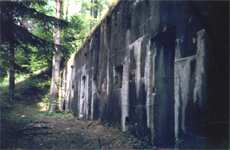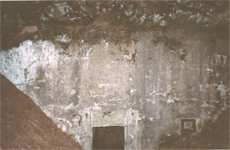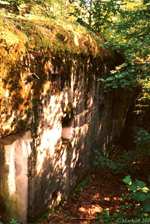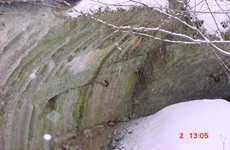© English version by Ervin Schieman & Cezary Markiel
 German war experiences, from the autumn 1914, proved that losing extensive territory around the Great Mazurian Lakes without a defence, can complicate and make it impossible the change to the offense. To this point, the Position of Mazurian Lakes had been left without protecting the bridges and defiles between the lakes of Ogonki, Pozezdrze, Kruklanki, Kruklin-Staswiny, Milki, Cierzpiety and Okartowo. With the enemy in control, these places could efficiently block any counteroffensive of the German army. In military situations this is a classical stalemate. The Germans were obliged to quickly reorganize all the systems of defence.
German war experiences, from the autumn 1914, proved that losing extensive territory around the Great Mazurian Lakes without a defence, can complicate and make it impossible the change to the offense. To this point, the Position of Mazurian Lakes had been left without protecting the bridges and defiles between the lakes of Ogonki, Pozezdrze, Kruklanki, Kruklin-Staswiny, Milki, Cierzpiety and Okartowo. With the enemy in control, these places could efficiently block any counteroffensive of the German army. In military situations this is a classical stalemate. The Germans were obliged to quickly reorganize all the systems of defence.
 General Ludendorf gave dispositions for the building of new fortifications in September 1914, including an extensive ring around the old Fortress Boyen in Gizycko. He planned a new so-called Field-Position Gizycko - FPG (Feldstellung Lötzen). The Germans created a closed defensive area, which would fight even in an encirclement. It was a mixture of a continuous field line and a ring fortress. FPG formed an oval area from Sniardwy Lake, Okartowo, Tyrklo Lake, Buwelno Lake, Staswiny Lake, Kruklin Lake, Kruklanki, Goldopiwo Lake, Sapina River, Stregiel Lake, Ogonki, Swiecajty Lake, Mamry Lake, Dobskie Lake, Dejguny Lake, Sterlawki Wielkie, Ilawki Lake, Guber Lake, Krzyzany, Rynskie Lake (gulf Rominek), Talty Lake, Mikolajskie Lake and Sniardwy Lake [map].
General Ludendorf gave dispositions for the building of new fortifications in September 1914, including an extensive ring around the old Fortress Boyen in Gizycko. He planned a new so-called Field-Position Gizycko - FPG (Feldstellung Lötzen). The Germans created a closed defensive area, which would fight even in an encirclement. It was a mixture of a continuous field line and a ring fortress. FPG formed an oval area from Sniardwy Lake, Okartowo, Tyrklo Lake, Buwelno Lake, Staswiny Lake, Kruklin Lake, Kruklanki, Goldopiwo Lake, Sapina River, Stregiel Lake, Ogonki, Swiecajty Lake, Mamry Lake, Dobskie Lake, Dejguny Lake, Sterlawki Wielkie, Ilawki Lake, Guber Lake, Krzyzany, Rynskie Lake (gulf Rominek), Talty Lake, Mikolajskie Lake and Sniardwy Lake [map].
In IX-X 1914, the Germans built only weak fortifications and so the Russians decided in autumn of 1914 to break German defence around Fortress Boyen. They broke the unfinished fortifications of FPG after heavy fighting in the region of the village of Cierzpiety (between Tyrlo & Buwelno Lakes). The Germans stopped the Russians near the MLP-line of Rydzewo, Paprotki, Woznice and Luknajno (near Mikolajki).
 After the expulsion of the Russians from the Great Lakes area in II 1915, the Germans started building. In 1915/17 they raised 255 shelters of different types and locations. These shelters were of several models located between forts. Bunkers were placed in deep excavations and covered with protective layers of earth. They were built from
concrete, where walls and ceilings were 1 - 1,5 m thick. Bunkers had internal cylindrical rooms, strengthened with wavy sheet metal. Shelters came in different versions including guard-shelters (Wachtraum-WR), readiness-shelters (Bereitschaftsraum-BR), infantry-shelters (Infanterieraum-IR), telecommunication-shelters (Fernmelderaum-FR) and observation shelters (Beobachtungraum-Beob.R). Typical strongpoints (Stützpunkt) were placed on local hills. They consisted of two IR-shelters (each for 2 platoons of infantry), a single BR-shelter and one (or two) WR-shelters for guard platoons. In a few strong points, the Germans built small observational posts and FR-shelters. The schelters' schemes. The distance between strong points was usually 1-3 km. On the eastern front FPG, the Germans positioned two infantry divisions, seated in 33 strong points. On northeast flank, the position was doubled with an additional internal line from Pieczonki-Spytkowo-Pieczarki with six additional strong points. The western front of FPG had one division of infantry, defending 12 strong points.
After the expulsion of the Russians from the Great Lakes area in II 1915, the Germans started building. In 1915/17 they raised 255 shelters of different types and locations. These shelters were of several models located between forts. Bunkers were placed in deep excavations and covered with protective layers of earth. They were built from
concrete, where walls and ceilings were 1 - 1,5 m thick. Bunkers had internal cylindrical rooms, strengthened with wavy sheet metal. Shelters came in different versions including guard-shelters (Wachtraum-WR), readiness-shelters (Bereitschaftsraum-BR), infantry-shelters (Infanterieraum-IR), telecommunication-shelters (Fernmelderaum-FR) and observation shelters (Beobachtungraum-Beob.R). Typical strongpoints (Stützpunkt) were placed on local hills. They consisted of two IR-shelters (each for 2 platoons of infantry), a single BR-shelter and one (or two) WR-shelters for guard platoons. In a few strong points, the Germans built small observational posts and FR-shelters. The schelters' schemes. The distance between strong points was usually 1-3 km. On the eastern front FPG, the Germans positioned two infantry divisions, seated in 33 strong points. On northeast flank, the position was doubled with an additional internal line from Pieczonki-Spytkowo-Pieczarki with six additional strong points. The western front of FPG had one division of infantry, defending 12 strong points.
Finished defensive positions did not engage in any battles in IWW, but in 1918 it was a unique and modern group of fortifications in East Prussia. This German enclave, from 1918 onward, stayed almost defenceless. The Ist German Corps had at its disposal the forces of only three infantry divisions, therefore it could efficiently defend only the Koenigsberg and the Sambia Peninsula.
 Until 1928 the areas near Gizycko were prohibited from building new fortifications. Nevertheless in the years 1925/26 the Germans secretly built 18 new structures of reinforced concrete - Doppel and Gruppenunterstand (one was disguised as being normal home near the bridge in Mikolajki). Allied Inspection Committees detected parts of these buildings and ordered stoppages and the destruction of finished structures. Numerous German protests and alarms raised by the Polish (and other adjoining countries) was the reason for the Paris - Conference (1927/28). After the German rejection of all Treaty limitations in 1935, the German Army began building the new fortifications of the Gizycko Fortified Region. From this moment on the old fortifications of the Field-Position Gizycko were included in the new system. They were intended to serve as personnel facilities, ammunition storage and as a third line of GFR defence.
Until 1928 the areas near Gizycko were prohibited from building new fortifications. Nevertheless in the years 1925/26 the Germans secretly built 18 new structures of reinforced concrete - Doppel and Gruppenunterstand (one was disguised as being normal home near the bridge in Mikolajki). Allied Inspection Committees detected parts of these buildings and ordered stoppages and the destruction of finished structures. Numerous German protests and alarms raised by the Polish (and other adjoining countries) was the reason for the Paris - Conference (1927/28). After the German rejection of all Treaty limitations in 1935, the German Army began building the new fortifications of the Gizycko Fortified Region. From this moment on the old fortifications of the Field-Position Gizycko were included in the new system. They were intended to serve as personnel facilities, ammunition storage and as a third line of GFR defence.
 German war experiences, from the autumn 1914, proved that losing extensive territory around the Great Mazurian Lakes without a defence, can complicate and make it impossible the change to the offense. To this point, the Position of Mazurian Lakes had been left without protecting the bridges and defiles between the lakes of Ogonki, Pozezdrze, Kruklanki, Kruklin-Staswiny, Milki, Cierzpiety and Okartowo. With the enemy in control, these places could efficiently block any counteroffensive of the German army. In military situations this is a classical stalemate. The Germans were obliged to quickly reorganize all the systems of defence.
German war experiences, from the autumn 1914, proved that losing extensive territory around the Great Mazurian Lakes without a defence, can complicate and make it impossible the change to the offense. To this point, the Position of Mazurian Lakes had been left without protecting the bridges and defiles between the lakes of Ogonki, Pozezdrze, Kruklanki, Kruklin-Staswiny, Milki, Cierzpiety and Okartowo. With the enemy in control, these places could efficiently block any counteroffensive of the German army. In military situations this is a classical stalemate. The Germans were obliged to quickly reorganize all the systems of defence. General Ludendorf gave dispositions for the building of new fortifications in September 1914, including an extensive ring around the old Fortress Boyen in Gizycko. He planned a new so-called Field-Position Gizycko - FPG (Feldstellung Lötzen). The Germans created a closed defensive area, which would fight even in an encirclement. It was a mixture of a continuous field line and a ring fortress. FPG formed an oval area from Sniardwy Lake, Okartowo, Tyrklo Lake, Buwelno Lake, Staswiny Lake, Kruklin Lake, Kruklanki, Goldopiwo Lake, Sapina River, Stregiel Lake, Ogonki, Swiecajty Lake, Mamry Lake, Dobskie Lake, Dejguny Lake, Sterlawki Wielkie, Ilawki Lake, Guber Lake, Krzyzany, Rynskie Lake (gulf Rominek), Talty Lake, Mikolajskie Lake and Sniardwy Lake [map].
General Ludendorf gave dispositions for the building of new fortifications in September 1914, including an extensive ring around the old Fortress Boyen in Gizycko. He planned a new so-called Field-Position Gizycko - FPG (Feldstellung Lötzen). The Germans created a closed defensive area, which would fight even in an encirclement. It was a mixture of a continuous field line and a ring fortress. FPG formed an oval area from Sniardwy Lake, Okartowo, Tyrklo Lake, Buwelno Lake, Staswiny Lake, Kruklin Lake, Kruklanki, Goldopiwo Lake, Sapina River, Stregiel Lake, Ogonki, Swiecajty Lake, Mamry Lake, Dobskie Lake, Dejguny Lake, Sterlawki Wielkie, Ilawki Lake, Guber Lake, Krzyzany, Rynskie Lake (gulf Rominek), Talty Lake, Mikolajskie Lake and Sniardwy Lake [map].
In IX-X 1914, the Germans built only weak fortifications and so the Russians decided in autumn of 1914 to break German defence around Fortress Boyen. They broke the unfinished fortifications of FPG after heavy fighting in the region of the village of Cierzpiety (between Tyrlo & Buwelno Lakes). The Germans stopped the Russians near the MLP-line of Rydzewo, Paprotki, Woznice and Luknajno (near Mikolajki).
 After the expulsion of the Russians from the Great Lakes area in II 1915, the Germans started building. In 1915/17 they raised 255 shelters of different types and locations. These shelters were of several models located between forts. Bunkers were placed in deep excavations and covered with protective layers of earth. They were built from
concrete, where walls and ceilings were 1 - 1,5 m thick. Bunkers had internal cylindrical rooms, strengthened with wavy sheet metal. Shelters came in different versions including guard-shelters (Wachtraum-WR), readiness-shelters (Bereitschaftsraum-BR), infantry-shelters (Infanterieraum-IR), telecommunication-shelters (Fernmelderaum-FR) and observation shelters (Beobachtungraum-Beob.R). Typical strongpoints (Stützpunkt) were placed on local hills. They consisted of two IR-shelters (each for 2 platoons of infantry), a single BR-shelter and one (or two) WR-shelters for guard platoons. In a few strong points, the Germans built small observational posts and FR-shelters. The schelters' schemes. The distance between strong points was usually 1-3 km. On the eastern front FPG, the Germans positioned two infantry divisions, seated in 33 strong points. On northeast flank, the position was doubled with an additional internal line from Pieczonki-Spytkowo-Pieczarki with six additional strong points. The western front of FPG had one division of infantry, defending 12 strong points.
After the expulsion of the Russians from the Great Lakes area in II 1915, the Germans started building. In 1915/17 they raised 255 shelters of different types and locations. These shelters were of several models located between forts. Bunkers were placed in deep excavations and covered with protective layers of earth. They were built from
concrete, where walls and ceilings were 1 - 1,5 m thick. Bunkers had internal cylindrical rooms, strengthened with wavy sheet metal. Shelters came in different versions including guard-shelters (Wachtraum-WR), readiness-shelters (Bereitschaftsraum-BR), infantry-shelters (Infanterieraum-IR), telecommunication-shelters (Fernmelderaum-FR) and observation shelters (Beobachtungraum-Beob.R). Typical strongpoints (Stützpunkt) were placed on local hills. They consisted of two IR-shelters (each for 2 platoons of infantry), a single BR-shelter and one (or two) WR-shelters for guard platoons. In a few strong points, the Germans built small observational posts and FR-shelters. The schelters' schemes. The distance between strong points was usually 1-3 km. On the eastern front FPG, the Germans positioned two infantry divisions, seated in 33 strong points. On northeast flank, the position was doubled with an additional internal line from Pieczonki-Spytkowo-Pieczarki with six additional strong points. The western front of FPG had one division of infantry, defending 12 strong points.
Finished defensive positions did not engage in any battles in IWW, but in 1918 it was a unique and modern group of fortifications in East Prussia. This German enclave, from 1918 onward, stayed almost defenceless. The Ist German Corps had at its disposal the forces of only three infantry divisions, therefore it could efficiently defend only the Koenigsberg and the Sambia Peninsula.
 Until 1928 the areas near Gizycko were prohibited from building new fortifications. Nevertheless in the years 1925/26 the Germans secretly built 18 new structures of reinforced concrete - Doppel and Gruppenunterstand (one was disguised as being normal home near the bridge in Mikolajki). Allied Inspection Committees detected parts of these buildings and ordered stoppages and the destruction of finished structures. Numerous German protests and alarms raised by the Polish (and other adjoining countries) was the reason for the Paris - Conference (1927/28). After the German rejection of all Treaty limitations in 1935, the German Army began building the new fortifications of the Gizycko Fortified Region. From this moment on the old fortifications of the Field-Position Gizycko were included in the new system. They were intended to serve as personnel facilities, ammunition storage and as a third line of GFR defence.
Until 1928 the areas near Gizycko were prohibited from building new fortifications. Nevertheless in the years 1925/26 the Germans secretly built 18 new structures of reinforced concrete - Doppel and Gruppenunterstand (one was disguised as being normal home near the bridge in Mikolajki). Allied Inspection Committees detected parts of these buildings and ordered stoppages and the destruction of finished structures. Numerous German protests and alarms raised by the Polish (and other adjoining countries) was the reason for the Paris - Conference (1927/28). After the German rejection of all Treaty limitations in 1935, the German Army began building the new fortifications of the Gizycko Fortified Region. From this moment on the old fortifications of the Field-Position Gizycko were included in the new system. They were intended to serve as personnel facilities, ammunition storage and as a third line of GFR defence.
Script Copyright © Cezary Markiel. 2000-2003 All Rights Reserved


fortyfikacje fortyfikacje schrony bunkry umocnienia fortyfikacje bunkry
